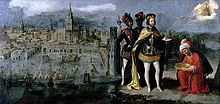| Siege of Seville | |||||||
|---|---|---|---|---|---|---|---|
| Part of the Reconquista | |||||||
 The Torre del Oro (at right) anchored one end of the barricade in the Guadalquivir. It marks where the Moorish defenses spanned the river. | |||||||
| |||||||
| Belligerents | |||||||
| Almohad Caliphate | |||||||
| Commanders and leaders | |||||||
| Axataf | |||||||
| Strength | |||||||
| Around 30.000 | Around 5.000 - 15.000 | ||||||
| Casualties and losses | |||||||
| Unknown | Unknown | ||||||
The siege of Seville (July 1247 – November 1248) was a 16-month successful investment during the Reconquista of Seville by forces of Ferdinand III of Castile.[1] Although perhaps eclipsed in geopolitical importance by the rapid capture of Córdoba in 1236, which sent a shockwave through the Muslim world, the siege of Seville was nonetheless the most complex military operation undertaken by Fernando III.[2] It is also the last major operation of the Early Reconquista. The operation also marked the appearance of indigenous naval forces of Castile-León of military significance. In effect, Ramón de Bonifaz was the first admiral of Castile, although he never held an official title of that kind.[3]
- ^ Joseph F. O'Callaghan (2004). Reconquest and crusade in medieval Spain. University of Pennsylvania Press. pp. 113–116. ISBN 978-0812218893.
- ^ Joseph F. O'Callaghan (1983). A history of medieval Spain. Cornell University Press. pp. 352–. ISBN 978-0801492648. Retrieved 12 October 2011.
- ^ O'Callaghan, J.F. (2011). The Gibraltar Crusade: Castile and the Battle for the Strait. University of Pennsylvania Press. p. 14. ISBN 978-0812204636. Retrieved 10 April 2015.